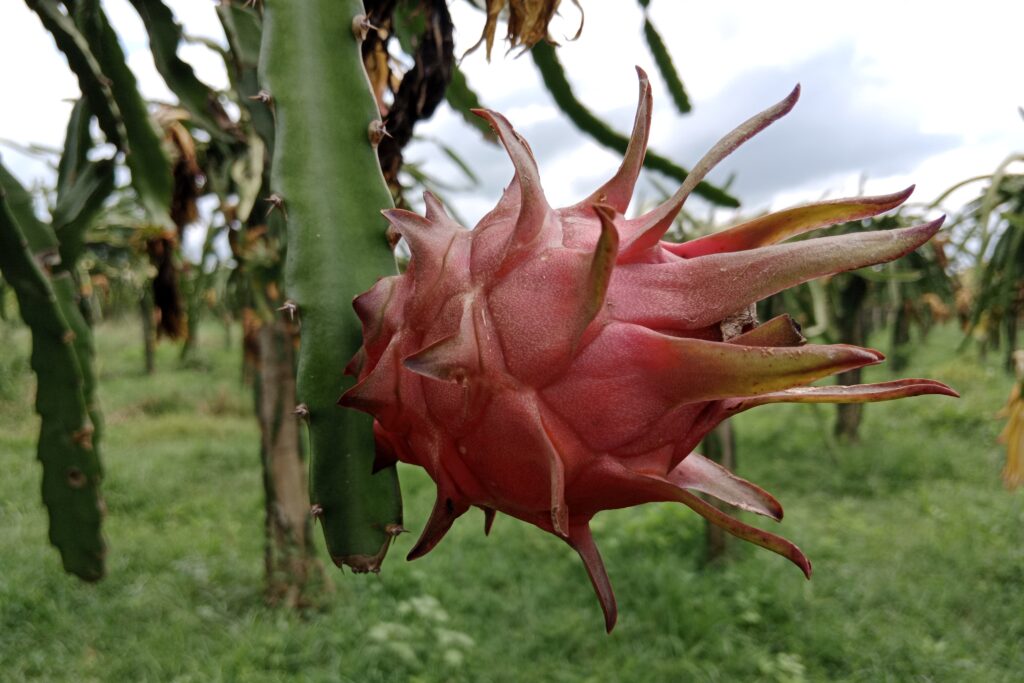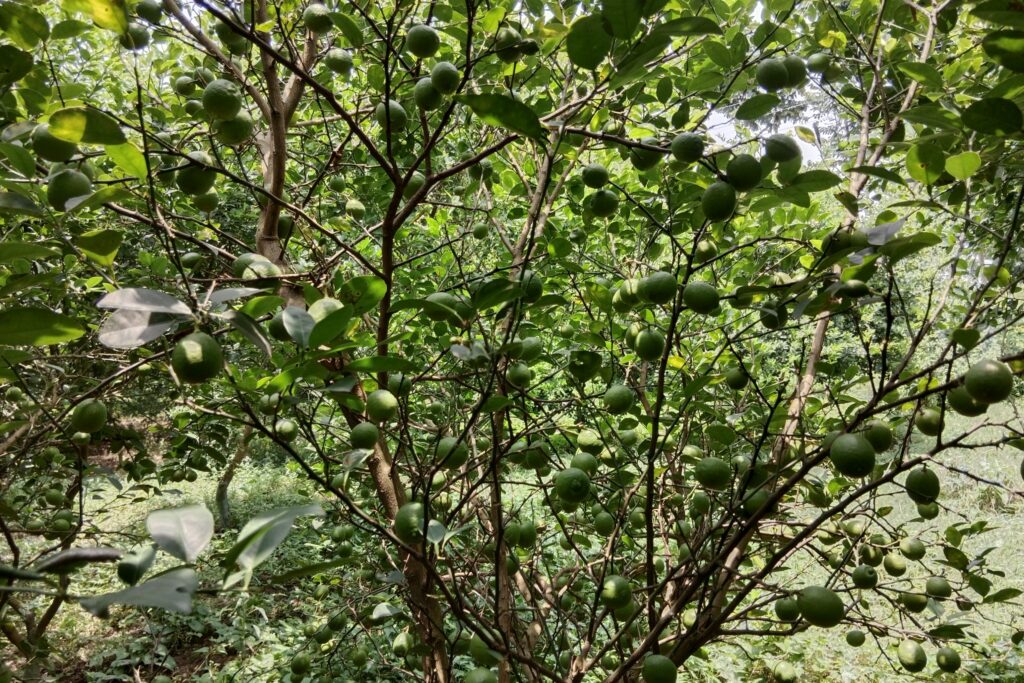Rudraksha Farming Profit Per Acre
Rudraksha farming involves the systematic cultivation of Elaeocarpus ganitrus, an evergreen tree renowned for its spiritually and medicinally significant seeds.
With increasing demand in religious, cultural, and therapeutic sectors, Rudraksha cultivation is gaining prominence as a sustainable, high-value agroforestry enterprise. Although the trees require several years to reach maturity, once established, they provide long-term economic returns with minimal maintenance.
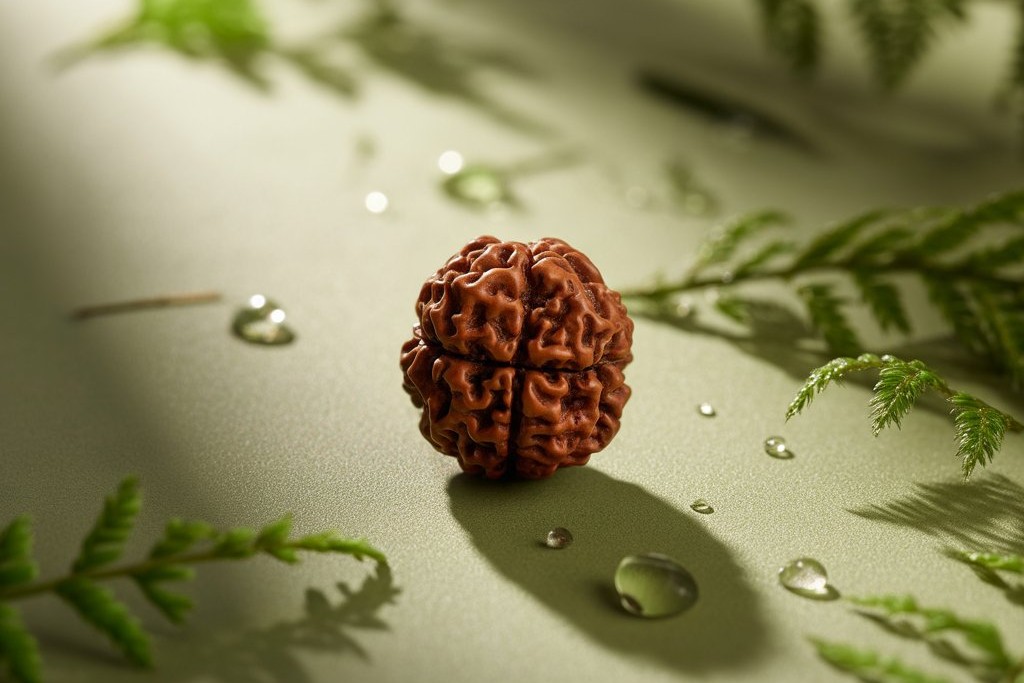
The Rudraksha farming profit per acre is defined by its exceptionally long gestation period, requiring nearly a decade of sustained investment before yielding returns, with farmers incurring losses for the first 10 years and only reaching breakeven around the 12th to 13th year.
Positive net profit is achieved in the 11th–15th year period, demanding significant patience and capital without immediate reward; however, from the 16th year onward, the venture becomes highly profitable, generating returns in millions, and after 25 years, it provides a stable, long-term income with minimal yearly expenses.
Ultimately, while the initial investment of approximately NRs. 23.89 lakhs per acre is substantial, the long-run Rudraksha farming profit per acre can be exceptional, with projections indicating a net profit exceeding NRs. 1.35 crore over a 50-year period, making it a highly rewarding, though patient, multi-generational investment.
Land Preparation
Land preparation plays a vital role in the successful establishment of Rudraksha trees and involves several important steps. The selected land should first be cleared of weeds, bushes, and previous crop residues to ensure a clean planting area.
This is followed by one deep plowing at a depth of about 30–45 cm to break up compact soil layers and improve aeration. Next, 2–3 cross harrowings are carried out to break down large soil clods and level the field, creating a fine tilth that supports healthy root development. Finally, basins are prepared around the designated pit locations to facilitate efficient irrigation and minimize water runoff.
Soil Type
Rudraksha trees grow best in deep, well-drained sandy loam to clay loam soils with a slightly acidic to neutral pH range of 5.5 to 7.0. Proper drainage is essential, as waterlogged conditions can lead to root rot and severely damage or even kill the plant. Since the tree develops an extensive taproot system, the soil should be at least 2–3 meters deep to support healthy growth and long-term stability.
Climatic Requirements
As a subtropical plant, rudraksha requires a particular climate to develop and produce well. It is not suited for harsh weather conditions because it grows best in warm, humid climates.
The ideal temperature for Rudraksha cultivation ranges from 25°C to 30°C. Since the plant is highly sensitive to frost, it cannot tolerate freezing temperatures, which can cause severe damage or even lead to plant death.
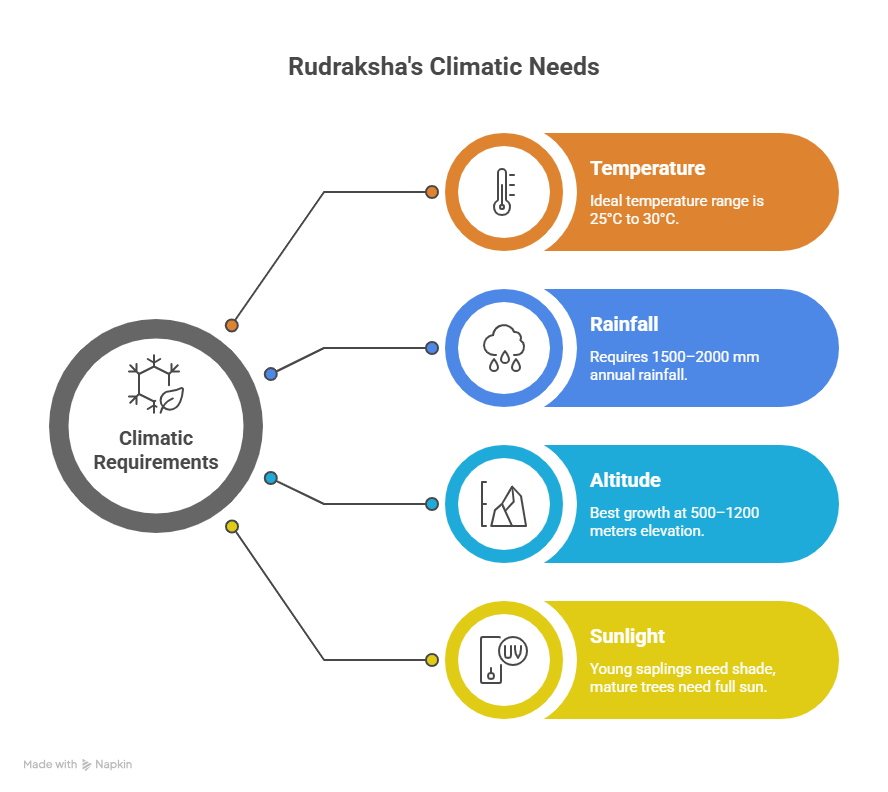
High humidity and sufficient rainfall are also essential for its growth. The tree performs best in regions receiving 1500–2000 mm of annual rainfall, particularly in areas with monsoon-influenced climates like the foothills of the Himalayas, where it naturally flourishes.
Rudraksha can be grown across a wide range of altitudes, from sea level up to 2000 meters. However, the most favorable results are generally achieved at elevations between 500 and 1200 meters, where the conditions closely align with its natural habitat.
Light requirements vary with the growth stage of the plant. Young saplings benefit from about 50% partial shade, which mimics the forest understory conditions where they naturally establish. In contrast, mature trees require full sunlight for optimum growth and fruit production.
Major Cultivars
Rudraksha cultivars are generally classified according to the number of mukhis (faces or clefts) present on the seed, which arises from natural genetic variation rather than formal plant breeding. Since no standardized horticultural varieties have been developed, cultivation primarily relies on seeds collected from healthy, high-yielding mother trees with desirable characteristics.
| Type / Number of Mukhis | Description | Rarity & Market Value |
| 5-Mukhi | The most common and widely available type. | Common; most accessible price point. |
| 6 to 14-Mukhi | Types classified by their increasing number of faces (clefts). | Less common; value and rarity increase significantly with the number of mukhis. |
| Gauri Shankar | A unique type where two seeds are naturally fused together. | Rare and highly valuable. |
Propagation
Rudraksha is primarily propagated by seeds. Vegetative propagation is challenging but possible.
Seed Propagation
Seed propagation of Rudraksha begins with the careful selection of fully ripe and healthy fruits from a known, high-quality mother tree to ensure strong and desirable seedlings. However, the seeds are naturally difficult to germinate because they possess a hard, impermeable coat and exhibit double dormancy, both physical and physiological, which requires extensive pretreatment.
The process starts with scarification, where the outer blue shell (epicarp) is carefully removed, and the cleaned seeds are soaked in water for 24–48 hours to soften the seed coat and initiate the germination process. Following this, stratification is carried out by mixing the soaked seeds with moist sand and storing them in a cool, shaded place for 45–60 days, which helps break physiological dormancy and significantly improves germination success, making the seeds ready for planting.
Vegetative Propagation
Vegetative propagation of Rudraksha is possible but generally has limited success. Hardwood stem cuttings treated with rooting hormones such as IBA can be used, though the success rate remains very low. Grafting and budding techniques, including approach grafting or patch budding onto seedling rootstock, can also be employed to clone specific mukhi types, but these methods require considerable skill and expertise to achieve reliable results.
Seed Rate per Acre
For Rudraksha cultivation, the seed rate per acre is calculated to achieve a final population of about 200 healthy, transplant-ready seedlings. Due to the long nursery period and the necessity of transplanting strong seedlings, approximately 400–500 seeds must be sown per acre. This accounts for the species’ slow and low germination rate of 40–60% even after pretreatment, as well as potential nursery losses of 30–40%.
Nursery Management
Nursery management for Rudraksha involves sowing pretreated seeds in well-prepared nursery beds or, preferably, in polybags filled with a growing media composed of soil, sand, and well-decomposed farmyard manure (FYM) in a 2:1:1 ratio.
The nursery should be placed under 50% shade, with the media kept consistently moist but not waterlogged to support healthy seedling development. Germination is often erratic, taking anywhere from 45 days to 6 months to begin, and seedlings are typically maintained in the nursery for 12–18 months until they reach a height of 45–60 cm and are sturdy enough for transplantation into the field.
Planting
a). Planting Season
The ideal planting season for Rudraksha is at the onset of the monsoon, typically during June–July, when consistent rainfall and cloud cover provide favorable moisture conditions that support successful establishment of the seedlings.
b). Spacing
Rudraksha is a large tree. A spacing of 6m x 6m is recommended.
c). Pit Preparation
Dig large pits of 60cm x 60cm x 60cm (2ft x 2ft x 2ft) at the marked spacing points. Keep the topsoil and subsoil separate.
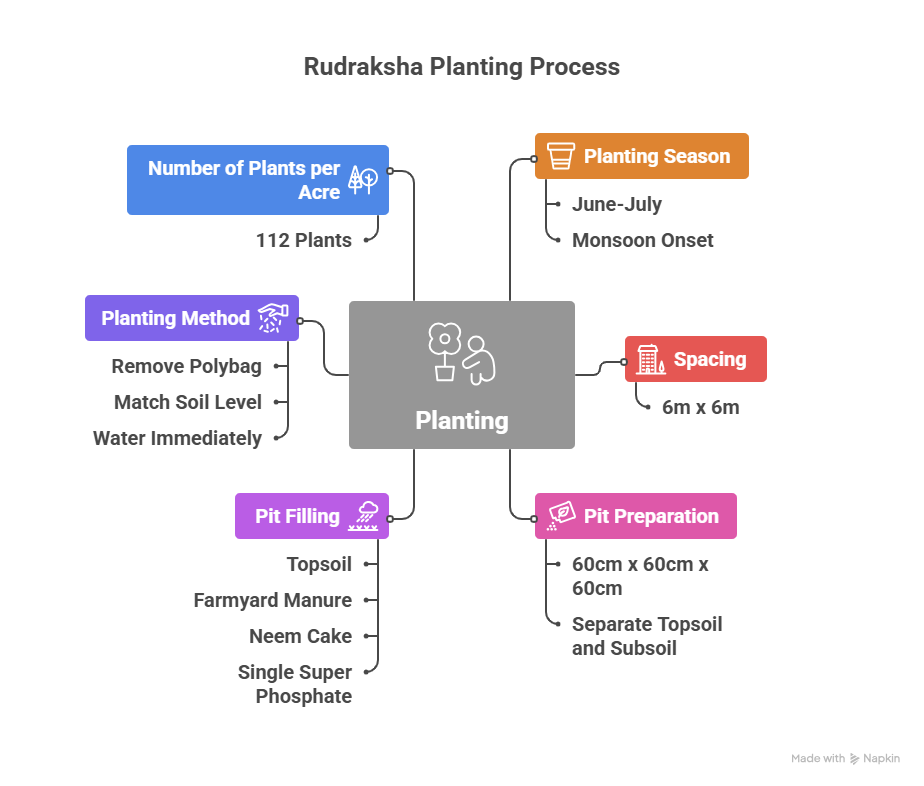
d). Pit Filling
For pit filling, refill each planting pit with a mixture of topsoil, 15–20 kg of well-decomposed farmyard manure or compost, 100 g of neem cake, and 500 g of single super phosphate (SSP). The pits should be prepared and filled 15–20 days prior to planting.
e). Planting Method
Carefully remove the polybag and place the ball of earth containing the seedling into the center of the prepared pit. The soil level should match that of the nursery. Lightly press the soil and water immediately.
f). Number of Plants per Acre
There can be roughly 112 Rudraksha plants per acre when spaced 6 m x 6 m apart.
Intercropping
Intercropping is highly recommended during the first 4–5 years of Rudraksha cultivation, as the wide spacing between the trees leaves the land largely vacant. Growing suitable shade-tolerant and shallow-rooted crops not only provides additional income but also helps control weeds.
Ideal intercrops include legumes such as beans and peas, which also enrich the soil with nitrogen, as well as turmeric, ginger, black turmeric, and leafy vegetables or radish. However, tall or deeply rooted crops should be avoided, as they compete with Rudraksha trees for nutrients and sunlight.
Irrigation
Young Rudraksha plants (1–3 years) require regular irrigation, particularly during the dry summer months, with watering recommended every 7–10 days.
Established trees (4 years and older) are relatively drought-hardy due to their deep root systems, but providing water during critical stages such as flowering (March–April) and fruit development (May–July) can significantly enhance yield.
Irrigation can be applied using basin methods, drip systems, or sprinklers to ensure adequate soil moisture throughout these crucial periods.
Fertilizer and Manure
Rudraksha responds exceptionally well to organic cultivation, thriving with the use of natural fertilizers and sustainable farming practices that enhance soil health and overall plant growth.
Fertilizer and Manure Application for Rudraksha
| Application Type | Recommended Inputs & Quantity | Key Notes |
| Basal Dose (At Planting) | 15-20 kg Farmyard Manure (FYM) + 500g Single Super Phosphate (SSP) per pit. | Applied during the initial pit preparation to provide essential nutrients for early root and plant development. |
| Annual Application (For Bearing Trees) | 50-60 kg of FYM/Compost + 1-2 kg of Neem cake per tree per year. | Organic inputs are preferred as the tree responds very well to organic cultivation practices. |
| Chemical Fertilizers (Optional) | Option 1: A balanced NPK mixture (e.g., 20:20:20) Option 2: 500g Urea + 500g SSP + 250g MOP (Muriate of Potash) per tree per year. | Use is optional. Applications must be based on soil test results to avoid over-fertilization. |
| Application Method | Apply all manures and fertilizers in a ring around the tree, just inside the drip line. Mix lightly into the soil. | The drip line is the area directly under the outer circumference of the tree’s branches, where the feeder roots are most active. |
Weed Control
Rudraksha cultivation requires frequent hand weeding or hoeing to reduce competition for nutrients and water, especially in the early growth phases.
In order to preserve soil moisture, inhibit weed growth, and enhance soil fertility as it breaks down, a layer of organic materials, such as dry leaves, paddy straw, or grass, is spread 10 to 15 cm thick around the base of the tree.
This technique is known as mulching, and it is thought to be quite effective. Due to the tree’s sensitivity and the inclination for organic growth methods, chemical weeding is typically avoided.
Interculture Operation
Intercultural operations in Rudraksha cultivation primarily involve training and pruning to ensure healthy growth and proper canopy development. Training focuses on establishing a strong framework with a single central trunk and well-spaced primary branches.
In the early years, pruning involves removing low-hanging, dead, diseased, or crossing branches to maintain the tree’s shape, while in mature trees, pruning is minimal and limited to the removal of dead wood, water shoots, and overcrowded branches to facilitate better light and air penetration into the canopy.
Flowering and Fruit Management
Rudraksha trees produce small, white, fringed flowers in dense racemes during spring (March to May), which are pollinated by insects, making a biodiverse farm environment important for supporting natural pollinators.
Following pollination, drupe-like fruits begin to develop, initially appearing green before turning blue upon ripening, each containing a single hard, pitted seed known as Rudraksha. The fruits typically mature and ripen within 6–7 months after flowering, usually around October to November.
Pest and Disease Management
Rudraksha trees are generally hardy and less prone to serious pest and disease issues, particularly when cultivated in their ideal climatic conditions. However, certain pests can still cause damage if not managed in time, and proper control measures are necessary to maintain healthy growth and productivity.
Common Pests
a). Stem Borer
The stem borer is considered the most destructive pest of Rudraksha. Its larvae bore into the trunk, weakening the tree and sometimes leading to dieback. For control, kerosene or neem oil should be carefully injected into the borer holes, after which the openings are sealed with clay to suffocate and kill the larvae.
b). Aphids & Mealybugs
Aphids and mealybugs are also common pests, primarily attacking young shoots and tender plant parts by sucking out the sap, which stunts growth and causes leaf curling or yellowing. To manage these pests, spraying with neem oil at the rate of 2–3 ml per liter of water or using a mild soap solution is effective.
If infestations are severe, insecticides like Imidacloprid 17.8 SL at 0.3 ml per liter of water or Dimethoate 30 EC at 2 ml per liter of water may be applied as a foliar spray, ensuring safety precautions and avoiding excessive chemical use to maintain the tree’s health and ecological balance.
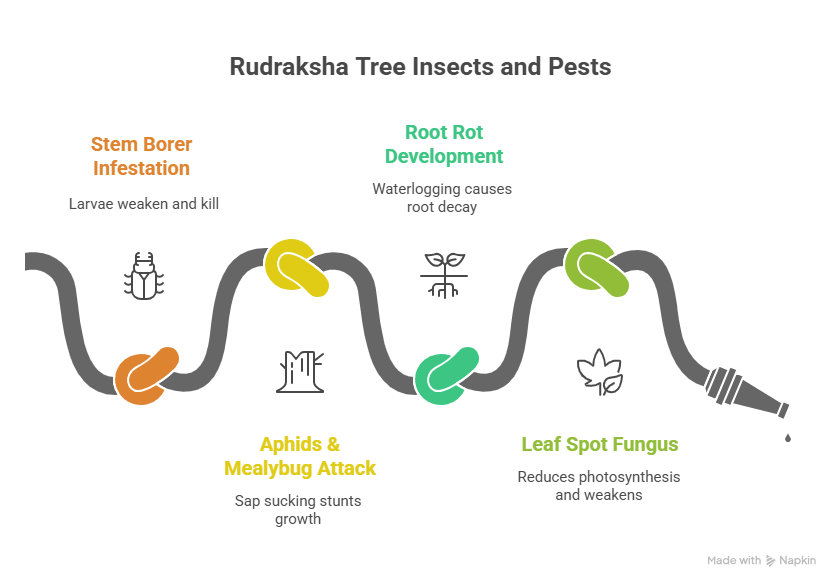
Common Diseases
a). Root Rot
Root rot is a serious problem that usually develops in poorly drained soils due to waterlogging. As there is no effective cure once the disease appears, prevention becomes the most important strategy. Maintaining proper drainage, avoiding excess irrigation, and planting trees on raised beds or mounds in high-rainfall regions are effective measures to minimize the risk of this disease.
b). Leaf Spot
A fungal disease called leaf spot causes black or brown patches on the leaves, which, if ignored, weakens the tree and reduces photosynthesis. Regular application of Bordeaux mixture (1%) or other copper-based fungicides is advised to prevent leaf spot. Disease incidence can also be decreased by maintaining field hygiene, which includes clearing away diseased leaves and enhancing airflow around the canopy.
Harvesting
Harvesting of Rudraksha begins when the fruits show maturity, indicated by the outer epicarp turning from green to bluish-black and some fruits start to drop naturally. For mature trees, fruits are usually collected from the ground, while in taller trees, branches may be shaken or poles used to dislodge ripe fruits, though manual picking by climbing is also practiced.
After collecting, the fruits are heaped for a few days to soften the pulp, after which the blue outer shell is removed through washing and rubbing to expose the hard, brown Rudraksha seed. The seeds are then carefully cleaned, shade-dried, graded according to size and mukhi count, and stored for further use.
Yield
Rudraksha yield is highly variable and depends on factors such as tree age, climate, and management practices. Trees begin bearing a small number of fruits after 7–10 years, with good commercial yields typically starting at 12–15 years.
A mature, healthy tree over 15 years old can produce 1,000 to 2,000 fruits annually, while very old trees over 50 years may yield more than 10,000 fruits. In a well-managed plantation with approximately 100 trees per acre, a 15-year-old orchard can produce around 100,000 to 200,000 fruits per acre.
The economic value of Rudraksha lies in its longevity and seed quality rather than weight, as trees can continue fruiting for over 100 years, making them a multi-generational asset.
Cost of Investment per Acre for Rudraksha Farming
| S.N. | Categories | Cost (NRs.) | |
| 1 | Land Preparation | 15,000 | |
| 2 | Planting Materials (Saplings) | 15,000 | |
| 3 | Planting (Labor) | 8,000 | |
| 4 | Fertilizers and Manure | 10,000 | |
| 5 | Irrigation System | 6,000 | |
| 6 | Weed Control | 5,000 | |
| 7 | Pest & Disease Control | 5,000 | |
| 8 | Harvesting (Labor) | 7,000 | |
| 9 | Post Harvesting (Processing) | 8,000 | |
| 10 | Miscellaneous Costs | 10,000 | |
| Total Initial Investment | 89,000 | ||
Annual Maintenance Cost per Acre for Rudraksha Farming
The annual maintenance cost per acre of rudraksha farming is estimated at NRs. 50,000, which covers essential activities required to ensure healthy growth and sustained productivity of the plantation.
This cost typically includes expenses for irrigation, application of fertilizers and organic manure, weed management, pest and disease control, labor charges for intercultural operations, and routine care of the trees.
Regular maintenance is crucial, especially during the initial years, as it helps improve plant survival, enhances yield quality, and minimizes the risk of damage from biotic and abiotic stresses. Over the long term, consistent investment in maintenance not only supports better seed production but also ensures the economic sustainability of the farming enterprise.
Income per Acre from Rudraksha Farming
| Year (Age of Plants) | Estimated Yield (Seeds/Acre) | Avg. Market Price per Seed (NRs.) | Total Income (NRs.) | |
| 8 – 10 Years | 5,600 | 50 | 280,000 | |
| 11 – 15 Years | 33,600 | 50 | 1,680,000 | |
| 16 – 25 Years | 100,800 | 50 | 5,040,000 | |
| 26 – 50 Years | 179,200 | 50 | 8,960,000 | |
| 51 Years & Onward | 200,000 | 50 | 10,000,000 | |
Analysis of Rudraksha Farming Profit Per Acre
| Period (Tree Age) | Cumulative Phase | Cumulative Income (NRs.) | Cumulative Costs (NRs.) | Net Profit/Loss (NRs.) |
| Year 0 | Establishment | 0 | 89,000 (Initial) | -89,000 |
| Years 1-7 | Juvenile (No Yield) | 0 | + 350,000 (50,000/yr x 7 yrs) | -439,000 |
| Years 8-10 | Initial Bearing | 280,000 | + 150,000 (50,000/yr x 3 yrs) | -309,000 |
| Years 11-15 | Young Bearing | + 1,680,000 | + 250,000 (50,000/yr x 5 yrs) | +1,121,000 |
| Years 16-25 | Medium Bearing | + 5,040,000 | + 500,000 (50,000/yr x 10 yrs) | +5,661,000 |
| Years 26-50 | Full Bearing | + 8,960,000 | + 1,250,000 (50,000/yr x 25 yrs) | +13,371,000 |
| TOTAL (50 Years) | NRs. 1,59,60,000 | NRs. 23,89,000 | ~NRs. 1,35,71,000 |
Rudraksha farming is characterized by a long gestation period, making it a true long-term investment. The initial years are not profitable, as the plantation requires nearly a decade of care and maintenance before yielding any significant returns. Farmers experience losses for the first 10 years, with the break-even point reached only around the 12th to 13th year.
A positive net profit is achieved during the 11th–15th year period, meaning the venture demands significant patience, sustained capital, and commitment without immediate financial rewards.
However, from the 16th year onwards, the farming becomes highly profitable, generating returns in millions, and once the plantation matures after 25 years, it provides a stable, long-term source of income with minimal yearly expenses.
Despite the delayed returns, rudraksha farming offers exceptionally high potential in the long run. Over a 50-year period, the total investment of approximately NRs. 23.89 lakhs could generate a net profit exceeding NRs. 1.35 crore.
This represents a substantial return on investment, but it is realized over an extended timeframe. Therefore, rudraksha farming is best suited for investors and farmers who can afford to wait patiently, as it is not a quick-profit venture but one that ensures remarkable financial rewards and sustainable income over the long term.
Rate of Rudraksha Value Based on Number of Mukhis (Ridges)
| Mukhi Count | Rarity Category | Approximate Price Range (per seed) |
| 2 Mukhi | Very Rare | NRs. 20,000 -NRs. 30,000 |
| 3 Mukhi | More Common | NRs. 300 – NRs. 500 |
| 6 Mukhi | Quite Common | NRs. 40 – NRs. 100 |
| 7 Mukhi | Semi-Rare | NRs. 500 – NRs. 1,000 |
| 8 Mukhi | High Demand | NRs. 1,500 – NRs. 3,000 |
| 9 – 11 Mukhi | Rare & Highly Valuable | NRs. 5,000 – NRs. 10,000 |
Sources
Food and Agriculture Organization (FAO)
University of California Agriculture & Natural Resources (UC ANR)
European Plant Protection Organization (EPPO)
Punjab Agricultural University (PAU)
Tamil Nadu Agriculture University (TNAU) – Agritech portal
Indian Council of Agricultural Research (ICAR)
Nepal Agricultural Research Council (NARC)
U.S. Department of Agriculture (USDA).
Ministry of Agriculture and Livestock Development (Nepal)
Disclaimer: This crop farming profits assume optimal conditions. Actual results may vary depending on climate, market prices, and farm management practices.

